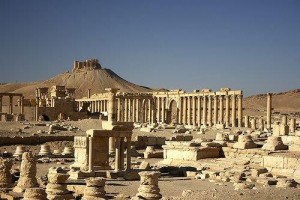The Role of Wahhabi Teaching, Internal Saudi Politics and the Role of the West in Creating the Conditions for ISIS to Emerge
ISIS together with its excessive violence and military success came as a surprise to most of us including our political leaders. This essay is an attempt to place ISIS and its cousins into a historical and religious context. ISIS and other manifestations of radical Islam may be an embarrassment to moderate Muslims and Western politicians but the problem comes from within Islam and cannot be defined away.
The Middle East has taken a sudden and dramatic turn toward increased instability with the public antagonism of Iran and Saudi Arabia. The immediate cause is the execution by Saudi Arabia of a Shiite cleric but the roots are both historic and more current.
 The alignment (of supporters of Saudi Arabia) follows the Sunni-Shia divide of the 7th century but is amplified by Arab-Persian competition that reaches back millennia plus the more current issues of oil and regional dominance. The nuclear accord has allowed Iran to lose its pariah status and again become a political actor to the chagrin of Saudi Arabia.
The alignment (of supporters of Saudi Arabia) follows the Sunni-Shia divide of the 7th century but is amplified by Arab-Persian competition that reaches back millennia plus the more current issues of oil and regional dominance. The nuclear accord has allowed Iran to lose its pariah status and again become a political actor to the chagrin of Saudi Arabia.
ISIS is not the cause of the immediate diplomatic tangle but it’s existence, success and behavior complicate the situation since it makes it more difficult for external powers (read USA) to support Saudi Arabia. With the real or perceived reduction of the Iranian nuclear threat attention has turned quickly to the roots of the more visible conflicts.
The headlines start with ISIS, Al-Qaeda and their cousins but sober analysis is quickly and consistently identifying the 18th century Wahhabi movement as the spiritual and philosophical parent of these movements. The movement originates in Saudi Arabia and is politically closely associated with the house of Saud.
The Saud dynasty was established in the 18th century by agreeing to a Faustian bargain with the founder of the Wahhabi movement – we have political power and you can dominate the religious sphere. A second Faustian bargain was struck between the West (USA and Britain ) after WWI. The House of Saud can run the new country of Saudi Arabia the way it wants to but we have assured access to oil. The modern version of these deals with the devil is that the Saudi Government and its wealthy citizens support Wahhabi activism around the Islamic world and beyond. The understanding is that their right to rule will then not be challenged. Goethe and Wagner would have felt such a complicated story line tested credulity!
These various chickens are now coming home to roost in a violent and dramatic fashion!
Western countries are increasingly speaking of Saudi Arabia and its policies as the primary source of Islamic extremism and consequently regional instability. This reality will threaten the close alignment of Western interests with the rich, conservative and illiberal oil monarchies of the Gulf.
To understand ISIS, Saudi Arabia and many aspects of the Sunni-Shia divide and current tensions it is important to understand the religious and political roots of Wahhabism. Brian Stiller, Global Ambassador of The World Evangelical Alliance has written an excellent summary on this subject and a portion of his analysis is attached with his permission.
I have limited the attachment to the portion which seeks to explain the historical and religious origins of the bewildering array of emerging extremist groups. It is a discouraging read since the annihilation of any one leader or group will do little to deal with the roots of the problem.
The Wahhabi Movement and the Origins of ISIS
What it is
ISIS (Daesh)* is a flowering thorn attached to a stem and rooted in a life-sustaining soil. ISIS is the bloom; an extremist messianic Wahhabism (Salafism) is the stem; a longing to return to radical Islamic tradition, to expel Western influence from the Middle East, and to launch global Islamic rule is its soil. To mix metaphors: “Daesh [ISIS] has a mother: the invasion of Iraq. But it also has a father: Saudi Arabia and its religious-industrial complex.”**
To say ISIS is not Islamic is disingenuous. But to tar all of Islam, and therefore Muslims, with this brush is like saying that Northern Ireland’s Protestant/Roman Catholic war represents all Christians or that Buddhist conflict in Sri Lanka or Myanmar is a sample of all Buddhists.
However, what is not understood is that ISIS’ roots reach back to the mid 1700s, from which emerged Al-Qaeda in Afghanistan in the late 1980s and ISIS in Iraq in 2006. Today we live with news of violence on a grand scale and are horrified by its rise to global prominence. ISIS is both notorious and mystifying. Most Muslims too are scandalized by this vicious and bloodthirsty mob, bewildered by its expansion, and unsure of its future.
ISIS’ religious beginning
Startled by its rapid rise in early 2014, yet ISIS is really a more virulent manifestation of an Islamic movement from the mid 1700s which was inspired by an Islamic cleric, Wahhab (Muhammad ibn ‘Abd-al Wahhab’, 1703-1792). Scandalized by what he saw as loose living and superstition, he believed Muslims should strictly observe Islamic rituals and follow a literal interpretation of the Quran. Under the Ikhwan, a tribal militia group, Wahhab’s influence rose in central Saudi Arabia. In 1744 Wahhab engaged with tribal leader Muhammad ibn Saud (his successors today are called the House of Saud), and over the next 150 years its influence fluctuated in the Arab Peninsula. While Wahhab taught that only by education and debate could Islam advance, Ibn Saud saw it otherwise, advancing faith by decapitating tens of thousands to build his political power base. After WWI the Saudi chief Abd-al Aziz consolidated his power with Wahhabist theology, creating in 1932 what today is Saudi Arabia.
The role of Saudi Arabia and Sunni Wahhabi fundamentalism surfaced in 1973 as the exploding price of oil gave Saudi Arabia money, influence and power. While Saudi Arabia’s prime export is oil, what is less known is its export of radical Islam. The Muslim World League opened offices where Muslims lived, funding the building of mosques, printing educational curriculum, and sending out Wahhabi preachers. As scholar Karen Armstrong notes, all the while they demanded “religious conformity in return for their munificence, so Wahhabi rejection of all other forms of Islam as well as other faiths would reach as deeply into Bradford, England and Buffalo, New York as into Pakistan, Jordan or Syria: everywhere gravely undermining Islam’s traditional pluralism.” (Author of Fields of Blood: Religion and the History of Violence)
Today the Saudi kingdom downplays radical Sunni Islam, although it accepts takfir in which a Muslim, such as a Shiite can be declared an unbeliever. This allows them then to kill other Muslims and enforce strict religious laws including cutting off hands of thieves, beheading criminals and stoning to death women accused of adultery. In the 1980s, encouraged by Saudi princes, many went to Afghanistan to expel the Soviets, and in the 1990s to Bosnia and Chechnya to support Muslims.
From that world Osama bin Laden rose to prominence, driven by a passion to rescue his Muslim community humiliated by infidels. Incensed that the US military was present in his homeland, in 1989 Al-Qaeda was created which in time morphed into ISIS (2006).
The long history of strict, sectarian Islamic doctrine found its beginnings in the Bedouin tribal militias of Ikhwan, inspired 270 years ago and played out in Paris, November 2015: one of the suicide bombers was, as reported, radicalized in a Wahhabi mosque in Chartres, France.
Division within Islam
Befuddling to non-Muslims is the major historical division within Islam. The majority of Sunni, who make up 87 percent of Muslims worldwide, are located mostly in Saudi Arabia, Egypt, Iraq, Pakistan, Turkey, Indonesia and most North African countries. The other 13 percent is Shia, its majority residing in Iran, as a majority in Iraq and a minority in India. Altogether there are 1.6 billion Muslims in the world.
In the hotbed of the Middle East these two factions often view each other as infidels, as they regard Christians or Jews. Their deep and hostile division was born from a dispute over succession after Mohammed died in 632 AD. This major fault line is partly political: Shia, or “followers of Ali,” link themselves with Mohamed’s son in-law, Ali ibn Abi Talib. The Sunni, or “people of tradition,” believe that selection is best made from the most qualified.
Next door to the Sunni majority of the Middle East is Iran, ethnically Persian and the global center of Shia. Next door to them is Saudi Arabia, both Arabic and Sunni and holder of the holy site of Mecca. Most Muslims in the Middle East – apart from Iran, Turkey and the Kurdistan province of Iraq – are Arabs. All this tinderbox needs is a spark: Saudi Arabians are both Sunni and Arab; Iranians are Shia and Persian. Arabs and Persians are hostile neighbors – one Persian and Shia, the other Arab and Sunni – contentious and fighting each other by way of proxy battles in Syria.
Antagonisms of the region are both contemporary and historic in people bred in the art of making fine their Islamic distinctions. Theirs is a region of world sites etched with memory of strong and vibrant Jewish and Christian communities, now nearly obliterated or vacated. Their political sensitivities have been grieved by foreign geographic rejigging of territory, as the West carved up its borders with the scratch of a pen.
We are witnessing a settling of historic grievances. (Recall a million military and civilians were killed in the Iran-Iraq war of the 1980s.) In more recent days we see the unsettling of peoples by the 2003 invasion; after the invaders popped the corks of fizzing cultures, we watched as they blew apart.
—————————————————————————–
* ISIS, means Islamic State of Iraq and Syria: ISIL the Islamic State in Iraq and Levant. (Levant an ancient term referring to eastern Mediterranean.) IS, meaning Islamic State, is so self-named to appear to the world that Islam is theirs to rule. Daesh is an acronym from Islamic Resistance Movement in Arabic.
** Kamel Daoud, New York Times
Brian C. Stiller
Global Ambassador, World Evangelical Alliance
December 2015






